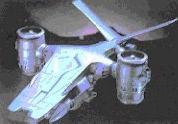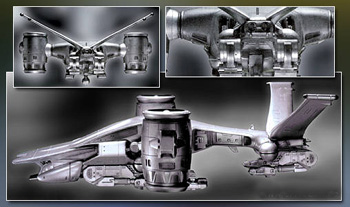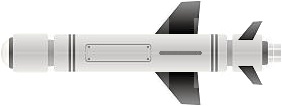
UGC Clariont Flag. | XTNDER II Heavy Observation/Light Attack Unmanned Pod. | 
UGC Clariont Flag. |
|---|
The XTNDR II Heavy Observation/Light Attack Pod was developed in 2212 amid an ongoing argument between the Galactic Security Committee (the militry's oversight committee) and the Robotech Expeditionary Forces;  | | XTNDER II Pod Upper Left Nose Aspect. |
|---|
 | | XTNDER II Pod 3 Views (Tail, Tail Detail, And Port Side). |
|---|
Complaints from FBX 21555320 of local soldiers and militias being unable to see in areas with restricted maneuvering using the original XTNDR Pod. The REF argued that the pod was working as intended. Additional complaints included that the XTNDR did not have MRI abilities; The REF argued, correctly, that the grav pods needed to gain the maneuvering abilities demanded by the Committee would make MRI impossible (focused grav waves interfere with the radio emissions that MRI depends on).The Committee didn't care. They wanted the REF to overcome the problem- Or else. The XTNDR II is the result, and leaves NOBODY happy with the results; Though the pod has installed grav pods, they must be shut down to use the MRI system and switch to A-11 style variable attack thrusters which are used for forward momentum under normal circumstances. The thrusters normally run almost dead silent (to hear them, you have to use specialized listening equipment), but to produce enough lift to keep the craft in the air they must be ramped up to full power, creating a moderate-pitched whine that can be heard for miles around. Additionally, the pod is so big it can not be carried on most Mecha (only the MAC-Series is big enough to carry them, and then only externally on the topside, where it can be plainly seen from the ground by anyone at least 21' away).However, despite the many shortcomings, the XTNDR II can be used independently of a ground station, or can jack in as normal. They can also be used as limited mules (1,000 lbs or less), or even as a medivac (2 life pods or even 3 HosBoxes). Also, the XTNDR II can be armed, unlike the XTNDR.The REF doesn't deploy the XTNDR II in any great numbers; Only one or two can be found in any given Battle Force, and none in an average Task Force. RDF's utilize them slightly more often, depending on total planetary conditions.The XTNDR2's odd airframe is partially due to it's development from a Ascension Supremacy drone (the Shark mini-fighter drone) and partially from the developers using a wrecked out Lamborghini for the initial research program.Name: XTNDER II.Model Type: Heavy Observation/Light Attack Unmanned Pod.Class: Automaton.Crew: None.Passengers: None.MDC By Location: |
Fuselage-
Crew Compartment-
Hatches (6)-
Engine Compartment- | 400
200 each
100 each
100 | Searchlights (2, top of crew compartment)-
Fuel/Ammo Pods (5)-
|
20 each
200 each
|
| Notes: Usual penalties apply.Speed and Statistical Data: |
Speed: 400 MPH max. NOTE: Due to the use of ultra-powerful grav pods, there is NO physical terrain that they can't traverse, period.
Hovering Height: From 2 to 10 ft.
Maximum Range: 20,000 miles.
Length: 31 ft 7.5 inches.
Wingspan: 25 ft 6.5 inches
Height: 10 ft 7.25 inches | Weight: 80 tons
Power System: SRh41 Hydro-Cell Engine; Output: 700 MGw at 17,000 hsp; Range: 2,000 miles.
Hover System: Standard grav pods.
Drive System: Twin SHr41 dual-phase aeration jets; Output: 22,000 hsp.
Cargo Capacity: 10 tons.
Cost and Availability: Between 10,000credit; Regularly available.
Black Market Cost and Availability: Between 1,000 and 50 millioncredit; Regularly available.
|
| Weapon Systems: |
|---|
1. Decoy Pods: The Steneirian style decoy pods still in use on the Steiner Fighter has been installed on the M-611 under a working agreement with the Steiner Republic. Unlike the pods installed on aero-space craft, however, tankers LOVE the pods. The decoys themselves are specially modified Mini-Missiles that produce burning globs of magnesium/aluminum alloy to confuse both radar AND heat sensory systems, as well as creating a lot of smoke to obscure the tank. NOTE: Though the modified mini-missiles combine smoke flares, AMC/FDs, and LDP's, they aren't powerful enough for use with Destroids & etc. Reduce effects by 20% against smart missiles (add +20% to rolls for smart missiles.)
Purpose: Defense.
Effect:
01-50: Enemy missile or missile volley detonates in chaff cloud - Missiles are all destroyed.51-75: Enemy missile or missile volley loses track of real target and veers away in wrong direction (may lock onto another target).76-00: No effect, missile is still on target.Also note that the chaff cloud will also blind nearby heat sensors (and optically based sensors at night) for 1 melee. They will suffer the following penalties: Reduce melee attacks/actions, and combat bonuses by half. Also, a cloud of smoke approximately 253 ft.
Duration: 1D4 melee rounds.
Rate of Fire: Once per melee.
Payload: 6 chaff/flares.
2. Forward Raidar X Tri-Laser: The Raidar X Tri-Laser was selected for the XTNDER II due to its unlimited ammo and range.
Purpose: Anti-Aircraft
MD Per Arm: Single blast- 3D6 MD. Dual Blast- 6D6 MD. Triple Blast- 1D4 times 10 MD.
Rate of Fire: Per pilots attacks per melee.
Range: 8 miles
Payload: Unlimited.
3. CU/l8tr: A medium range missile body with no effective warhead; Instead, it has a massive tracking system. A successful strike with a CU/l8tr will give follow up missile strikes a +5 to strike. Air based CU/l8tr's use laser targeting systems to put them on target (ground based CU/l8tr's use wire guidinace).
 Purpose: Targetting Purpose: Targetting
Effect: A successful strike with a CU/l8tr gives follow up strikes a +5 to strike; The initial impact will do a paltry 1D4 SD or 1 MD (whichever is more appropriate).
Rate of Fire: Once per melee.
Range: 20 miles
Payload: 5 missiles. | 4. Smoke Dispensers (70): This last-ditch system throws out smoke flares capable of covering a 2503 ft area. Special chemicals in the smoke obscures IR and heat sensors, and defeats visual tracking of the vehicle. Note that it DOESN'T make the vehicle invisible, but simply negates ALL bonuses to strike.
Purpose: Obscuring the craft for a few moments.
System Type: Active Defense.
Effect: Creates a cloud of smoke that covers a 2503 ft area.
Range: A 2503 ft area.
Coverage Characteristics: A full 360 degrees.
5. Variable Full-Force Barrier Field: The Variable Full-Force Barrier Field provides additional protection for the vehicle.
Purpose: Defense.
MDC: 200 per panel; 1,200 total available. NOTE: Each panel MUST still have 1 MDC for the system to continue working.
Effect: Provides 200 MDC in each of 06 panels.
Range: 40 ft.
Coverage Characteristics: A full 360 degrees coverage area around the craft.
6. Smoke Dispensers (70): This last-ditch system throws out smoke flares capable of covering a 2502 ft area. Special chemicals in the smoke obscures IR and heat sensors, and defeats visual tracking of the vehicle. Note that it DOESN'T make the vehicle invisible, but simply negates ALL bonuses to strike.
Purpose: Obscuring the craft for a few moments.
System Type: Active Defense.
Effect: Creates a cloud of smoke that covers a 2502 ft area.
Range: A 2502 ft area.
Coverage Characteristics: A full 360 degrees.
|
| Features: |
- Silvrite Armoring: Laser reflective armor; All lasers do half damage.
- Hearing Amplification: Can amplify sounds as quiet as 1 decibel at 1,000 ft, and in the ultra- and sub-sonic ranges.
- Video Recorder: Records from sensors and the cockpit itself. 500 hours of recording available.
- Radar: Combat grade radar. Range: 200 miles, can track up to 250 individual targets. 95% reliability (24% against unfriendly stealthed vehicles).
- FLIR/SLIR: Forward and Side Looking Infrared. Allows pilot and weapons officer to get visuals on targets at night.
- ESM: Radar Detector. Passively detects other radars being operated.
- AJP: Active Jamming Pod. Causes -25% to detection but when it is active, other vehicles/bases can detect that it is jamming, and some missiles will home in on jamming signals. Jamming also causes a -4 penalty to all radar guided weapons.
- Full Range Sensory Suite: Infrared, ultra violet, Magnification, night sight, color filters, thermal imager. Range is about 2,000 miles for MOST sensors.
- Fire Resistance: Fires external to the craft have no effect on it.
| - Motion Detector: Activates a loud wailing when an object is coming at the user fast, and a soft ringing if it's coming slowly. Activation ranges must be specified by the pilot.
- Anti-Jamming System: Reduces Electronics Countermeasure by 1/2 (decrease skill level appropriately).
- Electronic Counter Measures (ECM): These systems disrupt enemy radar and tracking systems, making it difficult for them to lock onto the ship with weapons. The countermeasures give the pod a +3 to dodge, +2 to strike and +1 on initiative in combat.
- Grav Clamps: Electro magnets in the underside of the hull allow the unit to adhere to the hulls of warships and the exteriors of SOME buildings.
- MRA 6 Radios: Allows real time, continuous radio link up with friendly forces in the area via satellite relay over laser radio signals, preventing jamming, and automatically encrypts/decrypts same to prevent eavesdropping.
- Type-11 Wide Band Radios: Effective 10 mile range, auto encrypt/decrypt. Works on standard radio band wavelengths, so it can still be jammed (if the enemy knows the frequencies).
|
Combat Profile for the XTNDER II Observation/Attack Pod:- 4 attacks per melee.
- +4 Parry, Dodge, and Roll.
- +2 Strike.
|